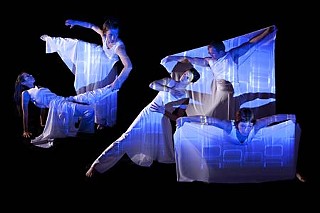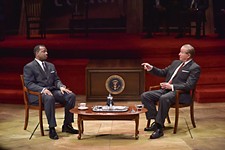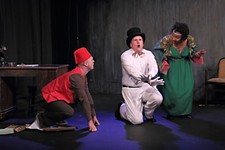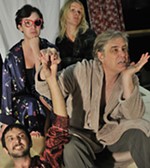The Grand Theory of Everything Between
What's undeniably grand about this new dance is Peter Stopschinski's music
Reviewed by Barry Pineo, Fri., May 20, 2011
The Grand Theory of Everything Between
The Off Center, 2211-A Hidalgo, 476-7833
Through May 21
Running time: 1 hr.
Andrea Ariel has probably made dance in Austin longer than you've lived here, and for almost two decades, her Ariel Dance Theatre has taken on some considerably larger-than-life subjects. In this original production, Ariel and her dancers, including
her frequent collaborators Steve Ochoa and Adriene Mishler, create a dance of our hidden universe, of those things we cannot see and those things perhaps only imagined. Quarks, black matter, aliens – you know the drill. The dancers are accompanied throughout by Peter Stopschinski, who conducts an orchestra of five executing his entirely original score.
Calling an ensemble of five an orchestra may sound strange, but their sound is nothing short of orchestral. With Stopschinski on piano and electronics, Henry Q. Vines on bass, Chuck Fischer on drums, Leah Nelson on viola, and Thomas Echols on guitar, the ensemble ranges broadly over styles and produces a dynamic and versatile sound as grand as the subject matter. Contributing mightily are Fischer's booming, emotional percussion and Nelson's dissonant, frantic strings. And make no mistake, Stopschinski conducts his musicians to accompany the dance, observing what is happening onstage and ensuring that the music works in concert with the movement. It's a solid hour's worth of stirring sound and a truly grand achievement.
I often found myself watching Stopschinski and his orchestra rather than the dance. It's quite possible that this was purposeful on Ariel's part. Ariel and her production designers, Natalie George and K. Eliot Haynes, have kept the Off Center in its usual proscenium configuration, with the audience on one side and the stage on the other. Stopschinski's orchestra is upstage on a wide platform and backed by a scrim, and the dancers primarily use the space between the orchestra and the audience, sometimes moving up onto the platform behind the orchestra, sometimes moving behind the scrim and appearing as shadows. Designer Kari Perkins has costumed all the dancers, three men and five women, in close-fitting tops and flowing skirts, and Ariel has choreographed long sections of the dance with lateral movement, going back and forth between the walls of the theatre. Now consider that almost everything you see is white – costumes, stage, scrim. With eight dancers moving laterally in white skirts against a white background, I often didn't know where to look, and while the universe and the things that happen in it can certainly be seen as a collection of quarks bouncing around and off of one another, combining to create different forms of existence, I longed for something more solid to rest my gaze on.
That ended up being the orchestra, not just because of the dynamism of the musicians or Stopschinski's focus and precision, but also because the musicians weren't all quite dressed in white. And it's not that things in the dance itself didn't stand out – Ochoa and Ariel have a brief duet together, and they dance so serenely, like two people who know each other well. Also, I sometimes saw animals and other recognizable forms rise from the mist, but I wanted more of a reason to watch those dancers because it really is a grand idea. It's certainly grand music. And who knows? It might just be the grand theory of everything between.











